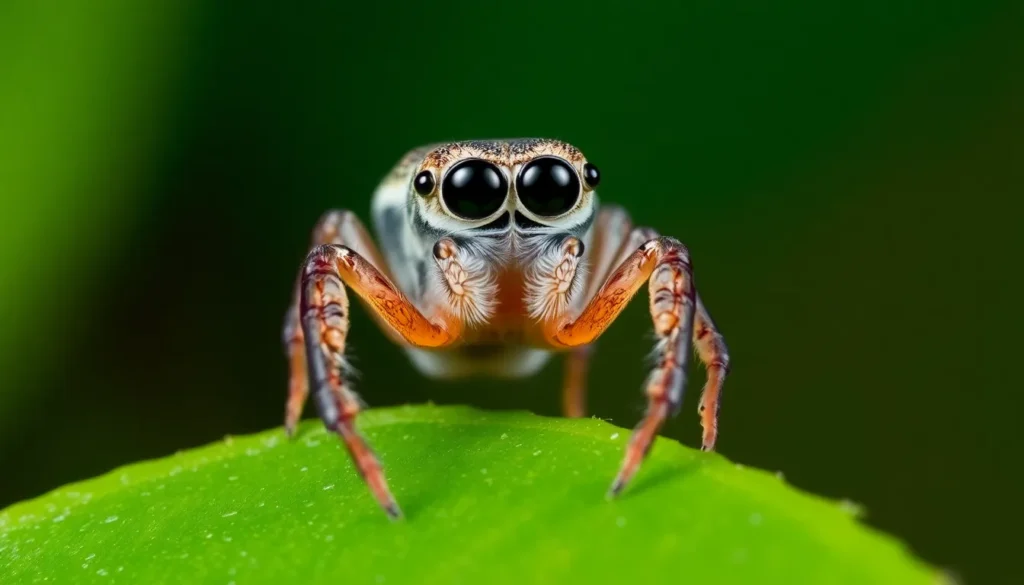Jumping spiders are fascinating creatures known for their impressive agility and unique hunting techniques. With their large, forward-facing eyes, they offer a captivating glimpse into the world of arachnids. But just how big do these remarkable spiders get?
While most jumping spiders are relatively small, some species can surprise enthusiasts with their size. Understanding the dimensions of these spiders not only enriches one’s appreciation for them but also helps in recognizing the various species that inhabit different environments. Join the exploration into the world of jumping spiders and discover the surprising range of sizes they can reach.
Table of Contents
ToggleOverview Of Jumping Spider Size
Jumping spiders typically range in size from 1 to 2 centimeters (0.4 to 0.8 inches) in length. Most species fall within this small size range, making them appear diminutive compared to other spider families. However, some notable exceptions exist. The largest species, such as the Hyllus diardi, can grow up to 3.5 centimeters (1.4 inches) long.
Interestingly, size varies among the over 6,000 species of jumping spiders. Factors contributing to size differences include habitat, diet, and ecological niche. For example, urban environments may host slightly larger specimens due to the abundance of food sources. Observers often notice a considerable size disparity even within the same group, depending on the species.
The size of these spiders plays a critical role in their hunting strategy. Larger jumping spiders may exhibit enhanced jumping abilities, allowing them to tackle bigger prey. Conversely, smaller species often exhibit greater agility. Understanding these size distinctions assists in identifying species and appreciating their behaviors in various environments.
Factors That Affect Size

Several factors influence the size of jumping spiders, including species variation and environmental influences.
Species Variation
Jumping spiders exhibit significant size differences among species. Some small species, like the Evarcha culicivora, measure just 1 centimeter (0.4 inches), while larger ones, such as the Hyllus diardi, can grow up to 3.5 centimeters (1.4 inches). Genetic factors dictate maximum sizes, with some species evolving adaptations for specific hunting strategies or ecological roles. The diversity found in more than 6,000 species contributes to this variation.
Environmental Influences
Environmental conditions significantly impact jumping spider size. Factors such as habitat availability, temperature, and food sources affect growth and development. Urban environments often provide abundant prey and shelter, leading to larger specimens. Conversely, harsh habitats with limited resources may restrict growth, resulting in smaller sizes. Furthermore, local climate variations, such as humidity and seasonal temperatures, shape the physical development of these spiders, influencing their size and behavior.
Comparison With Other Spider Species
Jumping spiders differ significantly in size compared to other spider species. While most jumping spiders range from 1 to 2 centimeters (0.4 to 0.8 inches), larger species like the Hyllus diardi can reach 3.5 centimeters (1.4 inches), making them notable among small to medium-sized spiders.
| Spider Species | Average Size (cm) | Size Range (cm) |
|---|---|---|
| Jumping Spiders | 1 to 2 | Up to 3.5 |
| Wolf Spiders | 2 to 4 | Up to 5.5 |
| Tarantulas | 8 to 30 | Up to 36 |
| Garden Spiders | 1 to 5 | Up to 10 |
Unlike jumping spiders, wolf spiders typically grow larger, with average sizes from 2 to 4 centimeters (0.8 to 1.6 inches) and a maximum size of 5.5 centimeters (2.2 inches). Tarantulas, contrasting in size and appearance, can reach 30 centimeters (11.8 inches), emphasizing the variance across different types.
Size influences behavior and ecological roles among spider species. Larger spiders, such as tarantulas, use their size for predation and defense, while the compact size of jumping spiders allows for exceptional agility and precision in hunting smaller prey.
Environmental factors also shape the growth of spider species. Jumping spiders in urban areas often grow larger due to plentiful resources and optimal conditions, leading to noticeable size differences when compared to those found in more pristine habitats.
Notable Jumping Spider Species
Various species of jumping spiders exemplify the size diversity within this family. Some notable large and small species exhibit unique characteristics and adaptations suited to their environments.
Large Species Examples
- Hyllus diardi: This species measures up to 3.5 centimeters (1.4 inches) in length. Found in Southeast Asia, it exhibits striking coloration and robust size, making it a prominent predator in its habitat.
- Salticus scenicus: Known as the zebra spider, it reaches up to 2.5 centimeters (1 inch). Common in urban areas, it uses its size to hunt insects effectively in gardens and buildings.
- Phidippus audax: This species can grow to about 2.5 centimeters (1 inch). It displays vibrant colors and is recognized for its hunting prowess, often preying on larger insects.
Small Species Examples
- Marpissa muscosa: Typically ranging from 0.5 to 1 centimeter (0.2 to 0.4 inches), this species thrives in grasslands and woodlands. Its small size allows it to navigate dense vegetation and evade larger predators.
- Salticus cingulatus: Measuring about 1 centimeter (0.4 inches), this species is often found in urban environments. Its compact form aids in agile movements during hunting.
- Evarcha culicivora: This small spider, around 0.4 to 1 centimeter (0.16 to 0.4 inches), specializes in preying on mosquitoes. Its size enables it to blend into its surroundings effectively.
Understanding these notable species highlights the diversity of jumping spiders and their adaptability to different habitats.
Jumping spiders showcase remarkable diversity in size and adaptability. While most species remain small and agile, some can surprise observers with their larger dimensions. This size variation not only influences their hunting strategies but also reflects their ability to thrive in various environments. Understanding the size range of jumping spiders enhances appreciation for these fascinating creatures and aids in recognizing their ecological roles. By exploring the unique characteristics of both small and large species, one can gain deeper insights into the adaptability and behavior of jumping spiders across different habitats.




